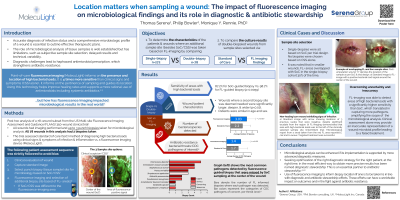Back

Clinical Research
(CR-029) Location matters when performing wound biopsies: impact on microbiological findings and treatment plan

Co-Author(s):
Phillip Bowler, PhD; Thomas Serena, MD FACS
<b>Introduction</b>: <p class="MsoNormal" style="text-align: justify;"><span style="font-family: 'Calibri Light',sans-serif; mso-ascii-theme-font: major-latin; mso-hansi-theme-font: major-latin; mso-bidi-theme-font: major-latin;">In situations where clinical signs/symptoms of wound infection may prompt clinicians to consider antibiotic therapy, wound tissue biopsy for microbiological analysis may provide guidance on most appropriate treatment. Choosing a biopsy site can be especially difficult in a large wound. Fluorescence (FL) imaging of bacterial loads is a rapid, non-invasive way of objectively locating microbial hotspots (loads >10<sup>4</sup> CFU/gr) in complex and/or large wounds and thus indicating an optimal site for biopsy collection. This study aimed to investigate the microbiology of wound tissue incisional biopsies taken from sites identified by FL imaging compared with sites selected by clinical judgement. </span></p><br/><br/><b>Methods</b>: <span style="font-size: 11.0pt; line-height: 107%; font-family: 'Calibri Light',sans-serif; mso-ascii-theme-font: major-latin; mso-fareast-font-family: Calibri; mso-fareast-theme-font: minor-latin; mso-hansi-theme-font: major-latin; mso-bidi-theme-font: major-latin; mso-ansi-language: EN-CA; mso-fareast-language: EN-US; mso-bidi-language: AR-SA;">A post hoc analysis of the 350 wound FLAAG Trial </span><span style="font-size: 11.0pt; line-height: 107%; font-family: 'Calibri Light',sans-serif; mso-ascii-theme-font: major-latin; mso-fareast-font-family: Calibri; mso-fareast-theme-font: minor-latin; mso-hansi-theme-font: major-latin; mso-bidi-theme-font: major-latin; mso-ansi-language: EN-CA; mso-fareast-language: EN-US; mso-bidi-language: AR-SA;"><span style="mso-no-proof: yes;">[1]</span></span><span style="font-size: 11.0pt; line-height: 107%; font-family: 'Calibri Light',sans-serif; mso-ascii-theme-font: major-latin; mso-fareast-font-family: Calibri; mso-fareast-theme-font: minor-latin; mso-hansi-theme-font: major-latin; mso-bidi-theme-font: major-latin; mso-ansi-language: EN-CA; mso-fareast-language: EN-US; mso-bidi-language: AR-SA;"> was conducted; 78 wounds were included in the present study.<span style="mso-spacerun: yes;"> </span>All 78 wounds had been biopsied at two different sites: one at the center of the wound per standard of care (SoC) and one site that was guided by FL-imaging findings, allowing for comparison of total bacterial load (TBL) and species present.</span><br/><br/><b>Results</b>: <p class="MsoNormal" style="text-align: justify;"><span style="font-family: 'Calibri Light',sans-serif; mso-ascii-theme-font: major-latin; mso-hansi-theme-font: major-latin; mso-bidi-theme-font: major-latin;">The 78 wounds were classified as microbiology positive if at least one of their biopsies had TBL ≥10<sup>4</sup> CFU/g. When compared to the original subset of 350 wounds, it seemed that clinical uncertainty was higher as wound surface area increased. Sensitivity of a FL-informed biopsy was 98.7% for accurately finding <em>any</em> bacterial loads >10<sup>4</sup> CFU/g, compared to 87.2% for SoC (p=0.0059; McNemar test). Regarding species detected, FL-informed biopsies detected an average of 3 bacterial species per biopsy versus 2.2 species with SoC (p < 0.001; t-test), i.e. microbial hotspots with a higher number of pathogens, including CDC pathogens of interest. </span></p><br/><br/><b>Discussion</b>: <p class="MsoNormal" style="text-align: justify;"><span style="font-family: 'Calibri Light',sans-serif; mso-ascii-theme-font: major-latin; mso-hansi-theme-font: major-latin; mso-bidi-theme-font: major-latin;">The evidence provided in this post hoc analysis suggests that choosing the sample site with the aid of FL-imaging results in a more representative and accurate depiction of the true microbiological status of the wound. This is of particular interest in large, complex wounds, as objectively evidenced in the wounds studied in this post hoc analysis. <span style="mso-spacerun: yes;"> </span>In addition, fluorescence imaging enables earlier bacterial detection and intervention, guiding early and appropriate wound hygiene and potentially reducing need for future antibiotic use. When indicated, this diagnostic partnership with antibiotic stewardship initiatives is key to ameliorating the growing resistance threat.</span></p><br/><br/><b>Trademarked Items</b>: <br/><br/><b>References</b>: 1. Le, L., et al., Adv Wound Care (2021).
2. CDC (2019).<br/><br/>
2. CDC (2019).<br/><br/>

.png)